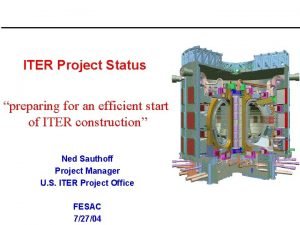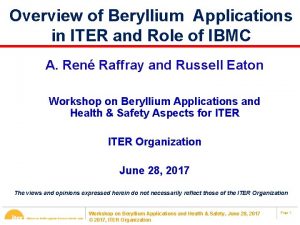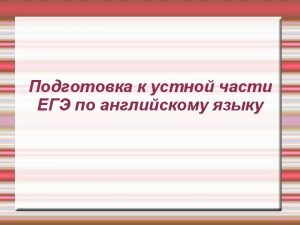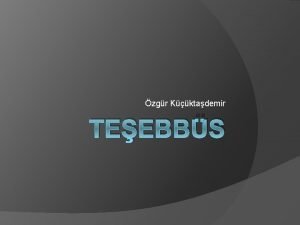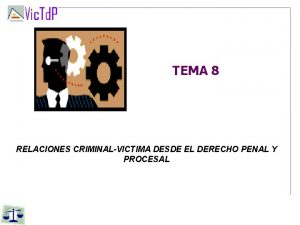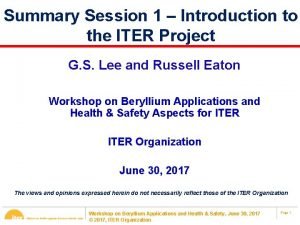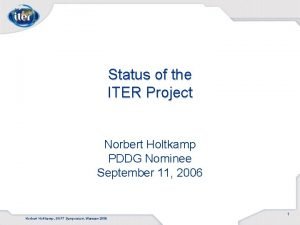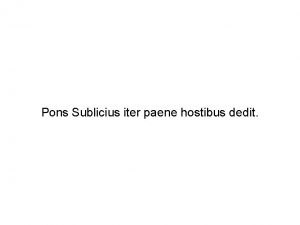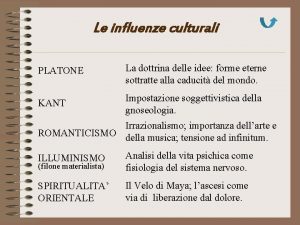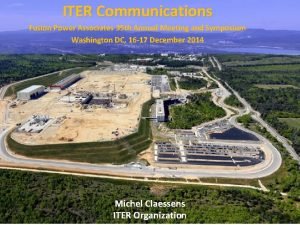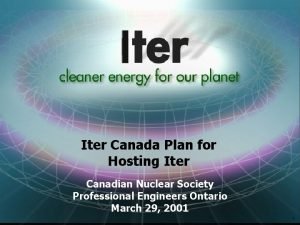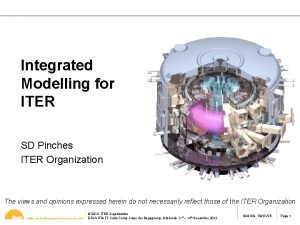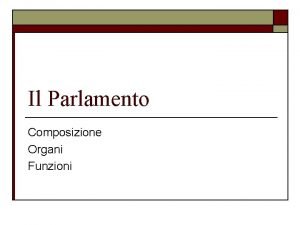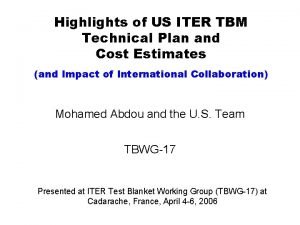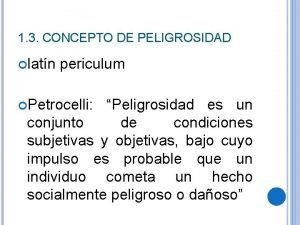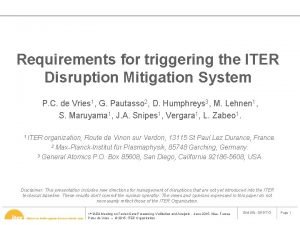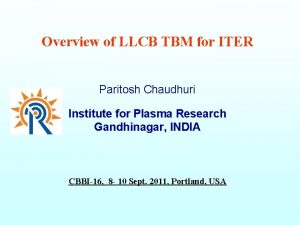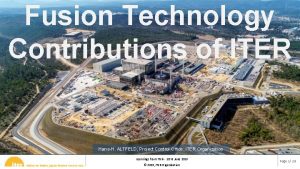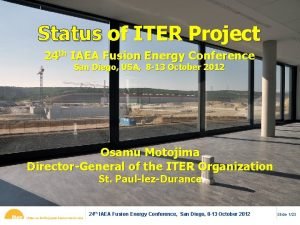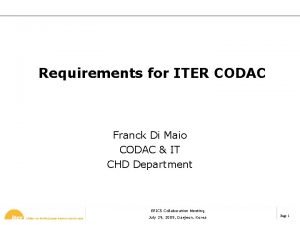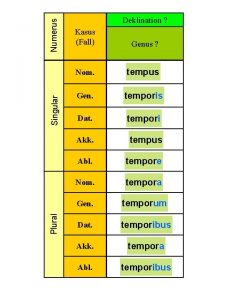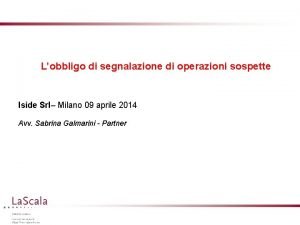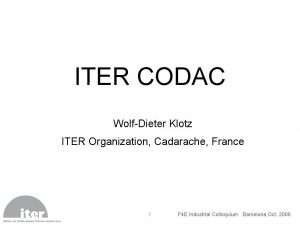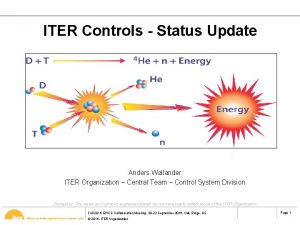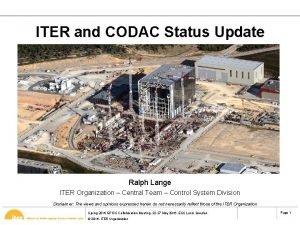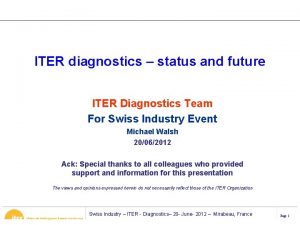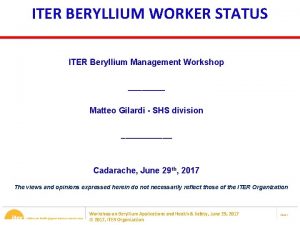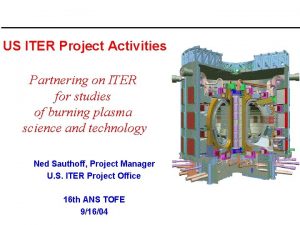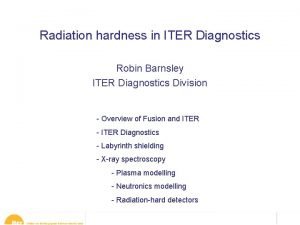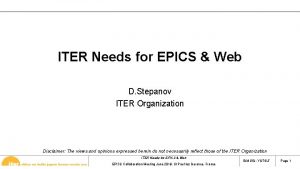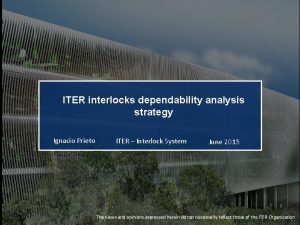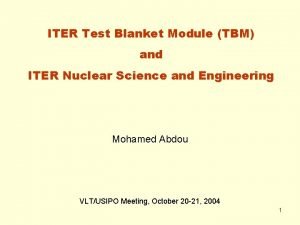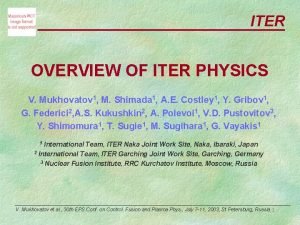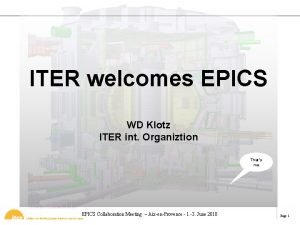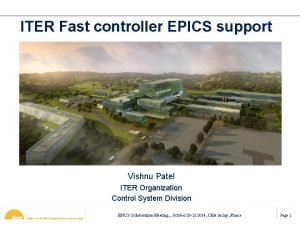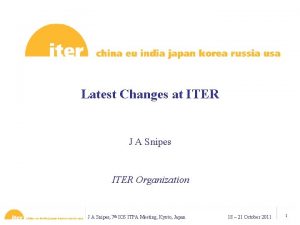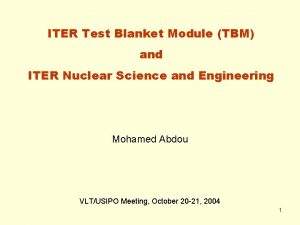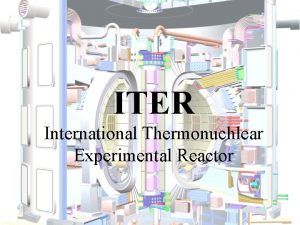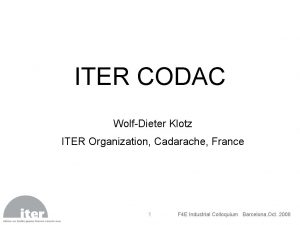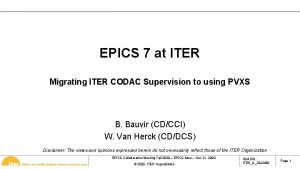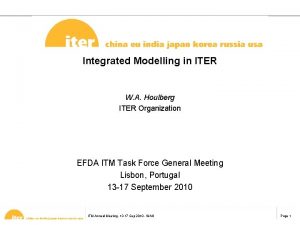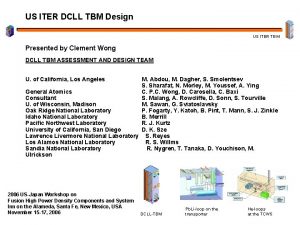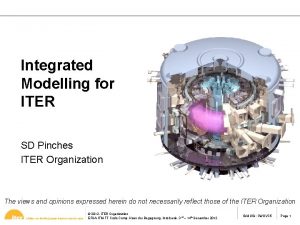ITER Project Status preparing for an efficient start


































- Slides: 34

ITER Project Status “preparing for an efficient start of ITER construction” Ned Sauthoff Project Manager U. S. ITER Project Office FESAC 7/27/04

Scope of the ITER Transitional Arrangements* • “Joint technical preparations directed at maintaining the coherence and integrity of the ITER design and at preparing for an efficient start of ITER construction” • “Organisational preparations directed at enabling the ITER Legal Entity to enter into effective operation with least possible delay following the entry into force of the ITER Joint Implementation Agreement”

US In-kind Contributions to ITER 4 of 7 Central Solenoid Modules Steady-state power supplies pellet injector 15% of port-based diagnostic packages 44% of antenna + all transmission lines, RF-sources, and power supplies Start-up gyrotrons, all transmission lines and power supplies Baffle Cooling for divertor, vacuum vessel, … Roughing pumps, standard components Tokamak exhaust processing system

Tentative US in-kind contributions by Value (total US in-kind contribution ~ 10%) Cooling for divertor, vacuum vessel, … 4 of 7 Central Solenoid Modules Steady-state power supplies Baffle 15% of port-based diagnostic packages Start-up gyrotrons, all transmission lines and power supplies Tokamak exhaust processing system Roughing pumps, standard components, pellet injector 44% of antenna + all transmission lines, RF-sources, and power supplies

Magnets: Central Solenoid Description of US portion US fraction of system (by ITER value) US Value (k. IUA) [$M] 4 of 7 Central Solenoid Modules 9% of full magnet system; 57% of central solenoid 74. 2 [$107 M]

CS Coil is Composed of 6 Pancake Wound Modules Each Module is slightly larger than the complete CS Model Coil

Central Solenoid Conductor

Mitigating the CS Magnet Technical Risks/Issues Tasks and Secondee Assignments Strand performance and supply Qualification of industrial suppliers of Nb 3 Sn strands with increased Jc Conductor performance and temperature margin Conductor performance and design criteria (transverse load effects) Fatigue life of Conductor Jacket • Jacket Materials characterization CS jacket weld defect assessment Failures of Butt-joints • Joint Development and Tests (butttype and lap-type) Integrated performance of the CS • Mechanical Characterization of CS modules, pre-compression structure and support structure Incomplete CS design and procurement specifications Secondees: Completion of CS Specifications and Procurement Package Stresses in the high-field regions of CS Modules Stress analysis of the helium inlet regions Indicates an approved task or secondee-assignment

Qualification of industrial suppliers of Nb 3 Sn strands with increased value of Jc (ITA 11 -18) • A Request For Proposal (RFP) was issued in May to 4 US strand vendors for the development and qualification of >100 kg of superconducting strand meeting a USproposed CS specification. • Offers were received from – Oxford Superconducting Technology – Superconducting Systems, Inc. – Supercon Inc. – Outokumpu Advanced Superconductors. Typical strand layout as proposed by OST. Diameter is ~0. 8 mm.

Stress Analysis of Helium Inlet Regions (ITA 11 -20) A preliminary analysis using a non-asymmetric 3 D ANSYS model of the CS winding pack has been carried out to assess the stress in the helium inlet region. Suggestions for redesign of the welded helium inlet have been made to lower the stress concentration in this area

Conductor Performance and Design Criteria (ITA 11 -22) • • • Sub-size jacketed CICC samples are undergoing testing in the Sultan facility. Both SS and Ti jacketed samples are included to help understand effects on conductor performance. The adequacy of the present conductor design and cost/performance ratios for design alternatives have been evaluated. A higher performance conductor design has been recommended and the result has been used to specify the strand for the development contracts.

CS Jacket Weld Defect Assessment (ITA 11 -23) Fatigue crack growth prediction using a statistical approach in order to estimate lifetime fatigue probability for the CS. Weld plate samples provided by JAERI

Plasma-Facing Components: Baffle Description of US portion US fraction of system (by ITER value) US Value (k. IUA) [$M] Module 18 (baffle) 10% of full system; 8. 6% of full blanket 14. 5 [$21 M]

ITER FW/Shield Design Module 18 of the FW/Shield – 36 modules around torus – Shield module weight 3. 6 Tonnes (316 LNIG steel) – PFC area 1. 6 m 2 – PFC weight 0. 8 Tonnes (Cu+316) – 10% of the first wall area – 45 cm thick (PFC +shield)

US ITER First Wall Tasks Development of the welded joint for the first wall leg, suited for cut and re-welding in the Hot Cell Qualification of the FW panel fabrication methods and to establish the NDT method for the FW panel. EM Analysis of modules and dynamic analysis of the key. Detailed design of blanket modules and thermal hydraulic analysis of the shield block and the total blanket system. Analysis of erosion of the ITER first wall due to plasma impingement

Ion Cyclotron System Description of US portion US fraction of system (by ITER value) US Value (k. IUA) [$M] 44% of antenna + all tranmission/RFsources/power supplies 91% of full system 31. 1 [$45 M]

Overview of the ITER IC system ITER ion cyclotron system block diagram What it is: What it can be used for: – One antenna, eight current straps – Tritium ion heating during DT ops. – Eight rf sources, each feeding – Minority ion heating during initial ops. one strap in the antenna – Current drive near center for AT – 35 -65 MHz operation – 20 MW total power to the plasma – Minority ion current drive at sawtooth inversion radius – Variable phasing between straps

Key: voltage probe fluoroptic temperature sensor

ICH High Power Prototype Fully Assembled

Electron Cyclotron System Description of US portion US fraction of system US Value (k. IUA) [$M] (by ITER value) Start-up gyrotrons, all 40% of full system transmission lines and power supplies 32. 3 [$47 M]

ECH on ITER • EC Current Drive (ECCD), off-axis. • EC Heating (ECH), including start-up. • Neoclassical Tearing Mode (NTM) stabilization.

ECH System / Allocations (24) 1 MW, 170 GHz Gyrotrons (EU, JA, RF) (24) DC Power Supplies (not shown) (US) (3) 1 MW, 120 GHz Gyrotrons (US) Transmission Lines (US) Equatorial Launcher (JA) (3) Upper Launchers (EU)

Vacuum Pumping and Fueling Description of US portion US fraction of system US Value (k. IUA) [$M] (by ITER value) Roughing pumps, standard components, pellet injector 37% of full system; 88% of selected subsystems 15. 0 [$22 M]

Pellet Injection and Pumping: R&D is starting • US starting R&D work for ITER Pellet Injection System – significant R&D to meet throughput and reliability needs – pressing issues have been identified with IT – ITER pumping packages require no R&D • ITER Pellet Injection workshop attended in May 2004 – Injectors to produce ~4. 5 mm pellets at up to 32 Hz – ORNL test of ITER guide tube mockup is underway – Gas gun approach for injector is under investigation

Diagnostics Description of US portion US fraction of system (by ITER value) US Value (k. IUA) [$M] Allocations being discussed 15% of full system (not including DNB) 20. 6 [$30 M]

ITER diagnostics landscape

US-assigned Diagnostics • Visible/IR Cameras (upper) • Reflectometer (main plasma – LFS) • MSE • ECE (main plasma) • Interferometer (divertor) • RGA

US ITER Tasks: Diagnostics Contribute to a Port Engineering Task Force. Support the ITER IT in the writing of procurement specifications for diagnostic port-based procurement packages.

US ITER Tasks: Other • Tritium Processing (S. Willms/LANL) – Detailed design and integration into overall fuel cycle of tokamak exhaust processing system based on the existing design • Safety (D. Petti/INEEL) Support and analysis for the latest fusion versions of computer codes MELCOR and ATHENA Magnet safety – Dust Characterization including mobilization and transport • Materials (S. Zinkle/ORNL) Support of materials activity

Scope of the ITER Transitional Arrangements* • “Joint technical preparations directed at maintaining the coherence and integrity of the ITER design and at preparing for an efficient start of ITER construction” • “Organisational preparations directed at enabling the ITER Legal Entity to enter into effective operation with least possible delay following the entry into force of the ITER Joint Implementation Agreement”

FY 04 US Secondees/Visiting Experts (~3 FTEs) • The present ITER international team consists of 69 persons: 31 from Europe, 21 from Japan, 13 from Russia, 3 from the US, and 1 from China, • US “Secondees”: – Magnets [Naka, Japan] • Nicolai Martovetsky (LLNL) and Philip Michael (MIT) – First Wall/Blanket [Garching, Germany] • Dr. Richard Nygren (Sandia) and Mr. Thomas Lutz (Sandia) – Ion Cyclotron [Garching, Germany] • David Swain (ORNL) and Richard Goulding (ORNL) – Port Plugs/diagnostics [Garching, Germany] • Douglas Loesser (PPPL) Approved

US ITER action items from the 6/04 IT/PTL and PC-3 meetings consider providing IT staff in the following areas: – – – codes and standards scheduling/project management risk management integration of heating systems CODAC tritium plant layout name U. S. contact person on CAD, IT and networking participate in review of the IT’s draft Risk Management Plan work with the IT risk-mitigation and risk-management for the magnets. respond to IT-initiated requests physics R&D and physics-design tasks

U. S. ITER Project Office OFES/ “BPCC” ITER Organization The organization will evolve

Summary • “Joint technical preparations directed at maintaining the coherence and integrity of the ITER design and at preparing for an efficient start of ITER construction” – The US is engaged in focused R&D and design activities in areas of US in-kind contribution and key project enablers • within the party and • via personnel seconded to the International Team – US emphasis is on risk mitigation via R&D, design, cost-estimation, and innovative procurement • “Organisational preparations directed at enabling the ITER Legal Entity to enter into effective operation with least possible delay following the entry into force of the ITER Joint Implementation Agreement” – The US has selected its Domestic Agency for the ITER Construction Phase – The US has offered to participate in development of the ITER Organization’s Project Management Plan, Risk Mitigation Plan, codes and standards, …. – The US is starting development of its Project Plans – The US ITER Project Office is drafting processes for open team-building
 Iter project status
Iter project status Productively efficient vs allocatively efficient
Productively efficient vs allocatively efficient Productively efficient vs allocatively efficient
Productively efficient vs allocatively efficient C b a d
C b a d Allocative efficiency vs productive efficiency
Allocative efficiency vs productive efficiency Productive inefficiency and allocative inefficiency
Productive inefficiency and allocative inefficiency Karttecken sten
Karttecken sten Iter project associate
Iter project associate Imagine that you are preparing a project with your friend
Imagine that you are preparing a project with your friend It's gotta start somewhere it's gotta start sometime
It's gotta start somewhere it's gotta start sometime Triage start
Triage start Iter criminis
Iter criminis Precipitación victimal
Precipitación victimal Iter ipa
Iter ipa Iter countries
Iter countries Pons sublicius iter paene
Pons sublicius iter paene Iter salvifico
Iter salvifico Iter progettuale
Iter progettuale Iter members
Iter members Iter countries
Iter countries Iter
Iter Schema parlamento italiano
Schema parlamento italiano Iter cost
Iter cost Iter criminis definicion
Iter criminis definicion Iter victimae etapas
Iter victimae etapas Iter
Iter Iter tbm
Iter tbm Longum iter est per praecepta breve per exempla
Longum iter est per praecepta breve per exempla Iter
Iter Iter fusion
Iter fusion Iter fusion
Iter fusion Iter codac
Iter codac Kasus singular plural
Kasus singular plural Iter segnalazione operazione sospetta schema
Iter segnalazione operazione sospetta schema Iter codac
Iter codac
